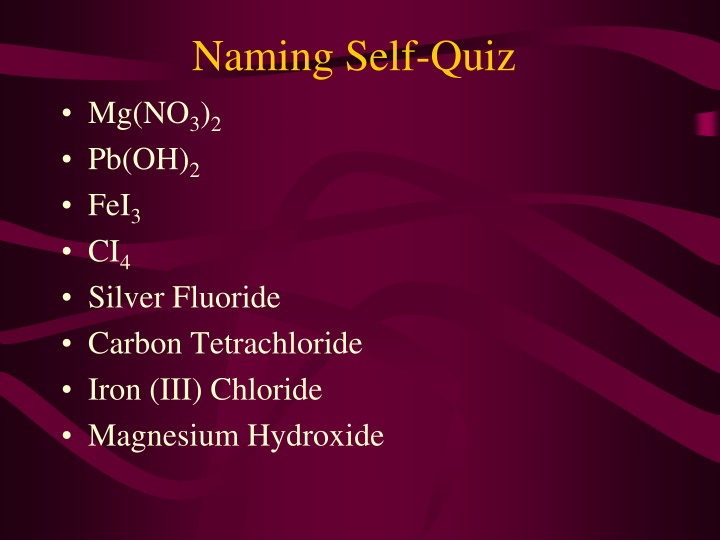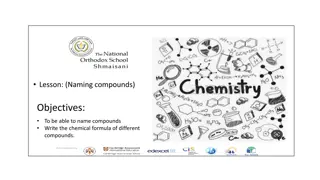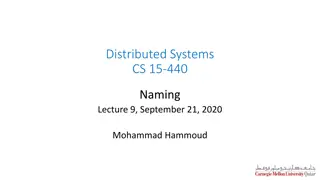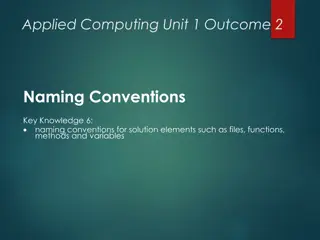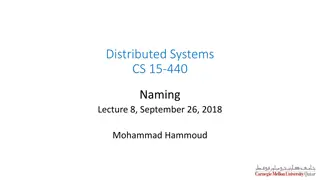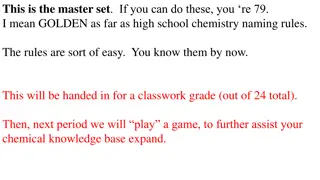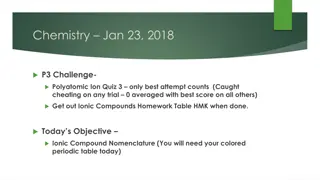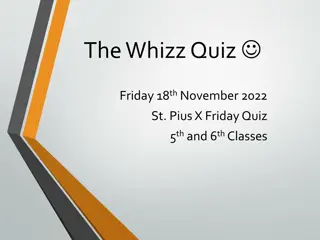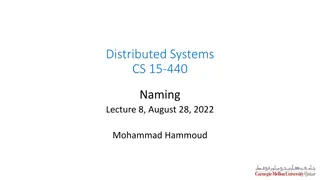Naming Self-Quiz
The world of chemical equations, from understanding reactants and products to describing states of substances using symbols. Dive into word equations, skeleton equations, and balanced chemical equations. Discover the importance of the law of conservation of mass in chemical reactions and explore examples illustrating its application.
Download Presentation

Please find below an Image/Link to download the presentation.
The content on the website is provided AS IS for your information and personal use only. It may not be sold, licensed, or shared on other websites without obtaining consent from the author.If you encounter any issues during the download, it is possible that the publisher has removed the file from their server.
You are allowed to download the files provided on this website for personal or commercial use, subject to the condition that they are used lawfully. All files are the property of their respective owners.
The content on the website is provided AS IS for your information and personal use only. It may not be sold, licensed, or shared on other websites without obtaining consent from the author.
E N D
Presentation Transcript
Naming Self-Quiz Mg(NO3)2 Pb(OH)2 FeI3 CI4 Silver Fluoride Carbon Tetrachloride Iron (III) Chloride Magnesium Hydroxide
Developing Chemical Equations
Chemical Equations A chemical change involves conversion of substances into other substances Reactants Products Reactants: pure substances that undergo a chemical change Products: pure substance that is formed in a chemical change (different properties than reactants)
Writing Chemical Equations 3 ways to represent chemical reactions: Word Equations Skeleton Equations Balanced Chemical Equations
Word Equations Describes a chemical reaction stating the reactants and products Reactant 1 + Reactant 2 Product 1 + Product 2 Example: hydrogen + oxygen water
Skeleton Equation Replaces words with chemical formulas to show the chemical composition of the substances Example H2 + O2 H2O
States The state of any substance in a chemical equation can be described using one of the following symbols: State State Solid Liquid Gas Aqueous (dissolved in water) Symbol Symbol (s) (l) (g) (aq)
States Example H2(g) + O2(g) H2O(l)
Law of Conservation of Mass In any given chemical reaction, the total mass of the products is always the same as the total mass of the reactants
Examples 4g hydrogen + 32 grams oxygen 36 grams water 103g potassium oxide + 9g water 112g potassium hydroxide 1g carbon + 5.34g sulfur 6.34g carbon disulfide
Balanced Chemical Equations Shows the units of reactants and products Demonstrates the law of conservation of mass same number of atoms of each element to appear on both sides of the equation
Coefficient : # placed in front of a chemical formula in a balanced chemical equation Example 2H2 + O2 2H2O 4 hydrogen + 2 oxygen 4 hydrogen, 2 oxygen
When balancing an equation, you CANNOT CANNOT add subscripts Subscripts change the identity substance identity of the 2H2O = 2 water H2O2 = hydrogen peroxide
Examples Word Equation Aluminum + Oxygen Aluminum Oxide Skeleton Al(s) + O2(g) Al2O3(s) Balanced 4Al(s) + 3O2(g) 2Al2O3(s)
Examples Word Equation Aluminum oxide + Calcium Calcium Oxide + Aluminum Skeleton Al2O3(s) + Ca(s) CaO (s) + Al(s) Balanced Al2O3(s) + 3Ca(s) 3CaO (s) + 2Al(s)
Examples Word Equation Calcium Chloride + Sodium Sulfate Calcium Sulfate + Sodium Chloride Skeleton CaCl2 + Na2SO4 CaSO4 + NaCl Balanced CaCl2 + Na2SO4 CaSO4 + 2NaCl
Examples Word Equation Carbon Tetrahydride + Oxygen Gas Carbon Dioxide + Water Skeleton CH4 + O2 CO2 + H2O Balanced CH4 + 2O2 CO2 + 2H2O
WORK Pg. 236 #3-7
